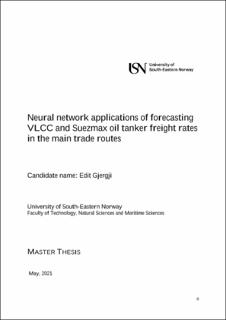| dc.description.abstract | Oil is one of the highest exported product in the world, accounting for 5,9% of the global value of all exported products. Forecasting the freight rates of oil tankers is of importance for many interest groups in the shipping market and oil market. The focus of this study is to understand how neural networks, specifically Levenberg-Marquardt, Bayesian Regularization and Scaled Conjugate Gradient algorithms perform for forecasting crude oil tanker freight rates, and if they provide better results than simpler methods. On the other hand, we focus to understand better what factors influence crude tanker freight rates. The study examines two vessel sizes VLCC and Suezmax, with three tanker routes, respectively the route from the Middle East to the U.S. (TD1), the route from the Middle East to Singapore (TD2) for VLCC and the route from the Black Sea to the Mediterranean (TD6) for Suezmax. The study takes into consideration nine variables which are: fleet development, bunker prices, new-building deliveries, crude oil demand, crude oil price, oil production, fleet development, fleet demolition, tanker order-book and new-building contracts collected for a period from May 2000 to December 2020. The variables are divided in three batches, and we see which of the variable groups performs best with each algorithm. We use MSE, R squared and RMSE as error measurement. We find that for short-term forecasting, for VLCC, the Scaled Conjugate Gradient algorithm performs best for batch two, by showing a smaller forecasting error. Regarding TD6 route by Suezmax, the best performing model is Bayesian Regularization. We compare the results with a simple naïve forecasting model, where for TD1 route it seems to perform good, but for the two other routes, neural networks outperform naïve forecasting. | |
